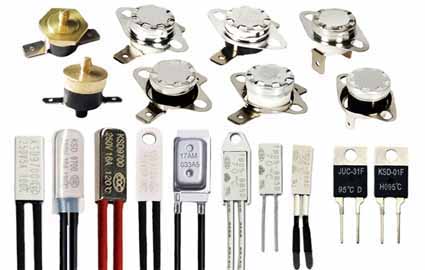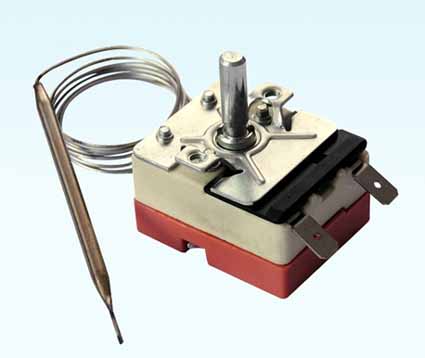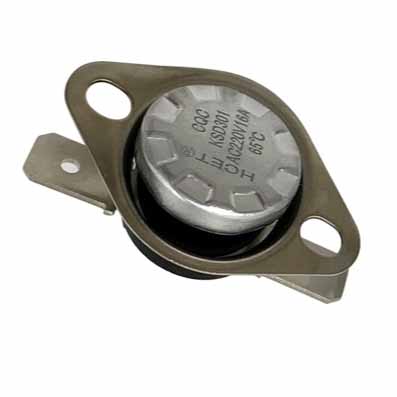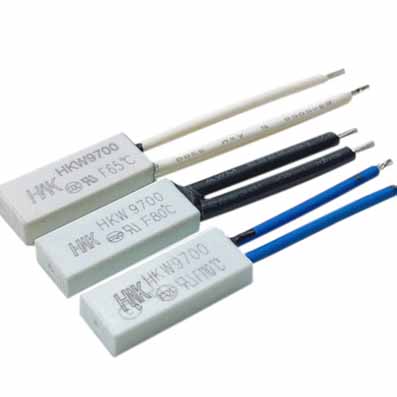What is a temperature control switch?

Do you know the function of the temperature control switch?
The temperature control switch works like a typical electrical switch used for on/off applications. The temperature control switch, also known as the temperature control switch, is an automatic and manual resettable power-off switch used for overheating protection. In this application, the temperature control switch operates to open or close at the process temperature of the action. The temperature control switch consists of two basic components, which you will find in all application designs: (KSD301, KSD9700, 17AM, TB02, capillary temperature control switch, 5AP/2MP/6AP/3MP+PTC/2AM/S01, adjustable temperature switch):(a) The sensing part immersed in the process where the temperature needs to be controlled. The sensing part may be a sensing ball (temperature sensing bulb) filled with liquid-liquid gas. Or use bimetallic strips with different expansions of two different metals.
(b) Snap-action contacts, used to turn on/off the power of the equipment that controls the temperature process.
How a Temperature control switch Works?
(Capillary thermostat) Liquid filled temperature control switches comprises a temperature sensing bulb and a bellows element. The bulb is immersed in the process whose temperature is being controlled. The bellows element senses fluid pressure (liquid or gas) as temperature increases within the process. Below is a schematic showing the basic operating principle of a Liquid expansion temperature control switch:
The working process of the capillary temperature control switch:
As shown above, the fluid in the temperature sensing bulb reacts to temperature variations and increases the pressure in the bellows element when temperature rises. A rise in the temperature sensing bulb temperature compresses the bellaws and moves the main spindle upwards until spring force and bellows pressure are in equilibrium. This movement of the spindle is transferred to the switch and causes on or off action depending on set point of the temperature control switch.
Suppose we are controlling the temperature of a water heater being heated by a burner system powered by an electrical circult and the Instantaneous water heater temperature is set at 65 °C . The temperature control switch will not activate so long as the water bath temperatu is below 65 °C . However when the temperature exceeds set point, the temperature control switch activates swritching off the electrical circuit controlling the burners. A temperature control switch having a bimetallic trip operates in similar fashion to the liquid filled system but the designs are markedly different Exterior.
Typical Terms / Specifications of Temperature control switches:
Adjustable temperature RangeThe span of temperature between upper and lower limits within which the temperature control switch can be adjusted to actuate or de actuate. It is typically expressed for increasing temperature.
Set action Point
That discrete temperature at which the temperature control switch is adjusted to actuate or de-actuate on rising. It must fall within the adjustable range and can be expressed as increasing or decreasing temperature.
Temperature action point spacing
The difference in temperature between the increasing set point and decreasing set point. It is normally fixed (not adustable).
Bimetallic SPDT Switch Element
Temperature switch Single-Pole, Double Throw (SPDT) switching element has three connections:
C-Common. NO-Normally Open and NC-Normally Closed, which allows the switch to be electrically connected to the circuit in either NO or NC state.
Bimetallic SPDT Switch Element
Temperature switch Single-Pole, Double-Throw (SPDT) switching element has three connections:
C-Common, NO-Normally Open and NC-Normally Closed, which allows the switch to be electrically connected to the circuit in either NO or NC state.
Bimetallic DPDT Switch Element
Temperature switch DPDT is two synchronized SPDT switching elements which actuate topether at increasing set point and de - actuate together at decreasing set point Discrete SPDT switching elements allow two independent circults to be switched; one AC and one DC.
Product Name : KSD301 Temperature Control Switch
Model: KSD301Action Temperature: -20~250°C
Action Type: N.C (Normal Close)
Rated Voltage/Current : 250V/16A, 10A
Pin Width : 6.3mm/0.25inch
Contact Life: More than 50,000 times (action times)
Electrical Strength: AC50Hz, 2000V/min no breakdown and arc phenomenon
Description :
1.Normally Closed: The original state of temperature control switch contact is closed, and open when the temperature sensing exceeds the rated temperature.
2.Feature: Double metal chip, contact sensor, speed dynamic type, sensitive, reliable, safe, stable action temperature, long service life, no arc phenomenon.
3. Advantage: General purpose, automatic reset, low cost, large capacity, minute current thermostats.
4. Function: It is closed until the temperature reaches 200 Celsius degree, then the switch opens. Widely used for temperature control or protection for household electric appliances.
5. Application: Mainly used for motor electric heating water dispenser, motor, water bottles, disinfection cabinet, coffee shell, electric iron, dryer, air conditioning, water heater, electronic cooker, heater, disinfection cupboard and motor cleaner etc.







